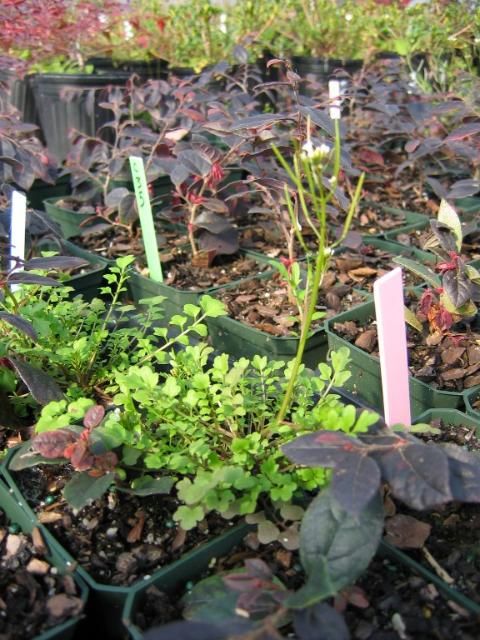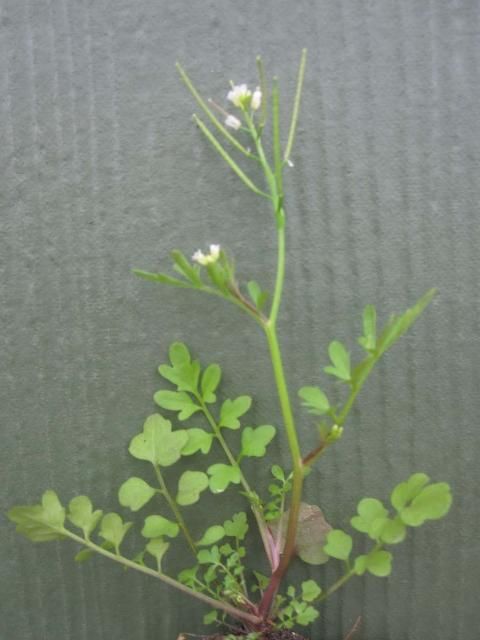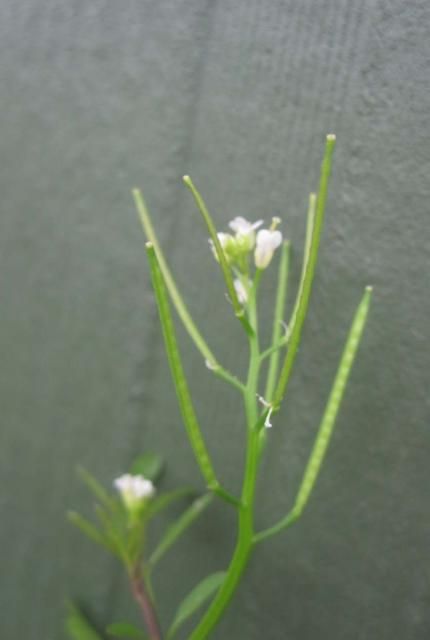Introduction
Hairy bittercress (Cardamine hirsuta) and other bittercress species (Cardamine ssp.) are the some of the most common cool season weed species in container nurseries in Florida. This EDIS publication was developed to help commercial nursery growers, lanscapers, and other green industry professionals identify and manage bittercress in greenhouses, nursery containers, and landscapes.
Species Description
Class: Dicotyledonous plant
Family: Brassicaceae (mustard family)
Other Common Names: Lamb's cress, spring cress, wood cress, flickweed
Life Span: Winter annual but can persist year-round in moist, shaded environments
Habitat: Occurs in disturbed areas; shores of rivers, lakes, swamps and wetlands; in greenhouses, container pads, growing media, and nursery pots. It is most often found in irrigated or shaded areas but can grow in full sun.
Distribution: Hairy bittercress (Cardamine hirsuta) is native to Europe and Western Asia and has been introduced and naturalized throughout much of the United States and the world, including parts of Eastern Asia, Africa, and Australia (Clapham, Tutin, and Moore 1987; USDA NRCS 2014). Several species of bittercress (Cardamine spp.) are problematic in nursery production with some species being native to the United States.
Growth Habit: Dense basal rosette or upright growth habit (Figure 1).

Credit: Chris Marble, UF/IFAS
Seedling: Cotyledons are small, round, and yellowish-green in color. The first true leaves are simple and slightly lobed (Figure 2).

Credit: Chris Marble, UF/IFAS
Shoot: Stems are usually 3 to 8 inches long and often reddish to purple in color toward the base of the plant and becoming greener up the stem (Figure 3). Leaves are alternately arranged on the stem, compound, may be lobed or slightly serrated, often club-shaped, and generally on the lower portion of the stem forming a basal rosette.

Credit: Shawn Steed, UF/IFAS
Roots: Fibrous
Inflorescence: Occurs at the top of the stem in clusters called racemes. Individual flowers are white with four petals and can have either four, five, or six stamens.
Fruit and Seeds: Small brown to black seed are produced in pods called siliques, which are cylindrical or cigar shaped and up to 1 inch long. The fruit is dry, and when mature it splits open and forcibly expels seeds up to 6 feet (Figure 4).

Credit: Shawn Steed, UF/IFAS
Similar Species: Several species of bittercress are common weeds in ornamental production. Pennsylvania bittercress (Cardamine pensylvanica) is a native species that is similar in appearance but often has fewer basal leaves and always has six stamens in the flower. Small-flowered bittercress (Cardamine parviflora), also called sand bittercress, is another similar species that can be distinguished from others by smaller leaves and growth habit and by its preference for drier habitats.
Plant Biology
Bittercress occurs throughout the year in Florida in shaded and moist areas but is most problematic in the fall through the spring during cooler temperatures, which are more favorable for germination and growth. One bittercress plant can produce five thousand seeds (Bachman and Whitwell 1994) which have no dormancy requirement and can germinate quickly. In cases where environmental conditions are not conducive to germination, bittercress seed can remain viable in the soil or potting for several years. Bittercress seeds are small and sticky when wet, making them prone to sticking to the sides of empty containers or being transported on shoes or clothing of nursery employees. Upon germination, bittercress can reach maturity and begin flowering and seeding in as little as five weeks under favorable conditions. Bittercress is a known host for other common nursery pests including whiteflies, mites, and some diseases (Neal and Derr 2005).
Management
Physical and Cultural Control
Bittercress commonly grows in the potting media of container-grown ornamentals and often through drainage holes in nursery containers (Figure 5). It also can be a problem in propagation houses, greenhouses, and in the field. Bittercress prefers moist environments, but reducing irrigation is often impractical in a container production setting. Hand weed plants before they reach the flowering stage, as seeds can be dispersed by hand contact. Remove the pulled plants from the area and dispose, as they can continue dispersing seeds even when removed from the soil. Control bittercress in non-crop areas by mowing (when seeds are not present), and using densely growing groundcovers or a gravel layer to improve drainage and reduce germination. Coarse-textured mulches at depths of three inches or more also can reduce germination in nursery containers (Richardson et al. 2008). Inspect new plant shipments for bittercress infestations prior to potting or transplanting, as it is a common weed in propagation greenhouses. Sanitation is critical to prevent the germination and spread of bittercress in ornamental production. Ensuring that reused nursery containers are washed and free of debris can significantly reduce the number bittercress seedlings in nursery containers (Bachman and Whitwell 1994).

Credit: Annette Chandler, UF/IFAS
Chemical Control
Preemergence
Bittercress is effectively controlled with most preemergence herbicides. However, containers must be weed-free prior to application, as these products generally do not work on emerged plants. While these products do provide control, bittercress continues to be a difficult weed to control due the number of seeds produced as well as its fast germination and growth throughout the year. Table 1 includes a partial list of preemergence herbicides labeled for control in and around ornamentals. Indaziflam (Marengo®, OHP, Inc.) is labeled for use on greenhouse floors, but greenhouses should be empty during application. Ornamentals can be placed back inside 24 hours after treatment. Similarly, flumioxazin (SureGuard®) can be used on greenhouse floors if the house is empty. Both herbicides can be tank-mixed with many different postemergence herbicides such as RoundUp® (glyphosate) to control existing weeds.
Postemergence
There are many different postemergence products that are effective on bittercress and can be used in non-crop areas or in landscapes or fields as a directed application. Effective active ingredients include glyphosate (RoundUp®), glufosinate (Finale®), diquat (Reward®), and pelargonic acid (Scythe®), among many others. The spray formulation of flumioxazin (SureGuard®) can provide both pre- and postemergence control, but it is labeled only as a directed application. Both systemic and contact herbicides will provide effective control, though thorough coverage is needed for contact herbicides such as diquat or pelargonic acid. Very few products are labeled for use over the top of ornamentals in production or in the landscape. However, research has shown that the preemergence herbicide isoxaben (Gallery®) can provide early postemergence control to small bittercress less than 2.5 inches tall before flowering (Altland, Gilliam, and Olive 1999). When using any herbicide, always consult the manufacturer's label and follow all precautions.
Disclaimer: Mention of a commercial or herbicide brand name or chemical does not constitute a recommendation or warranty of the product by the authors or the University of Florida, Institute of Food and Agricultural Sciences, nor does it imply its approval to the exclusion of other products that may also be suitable. Products should be used according to label instructions and safety equipment required on the label and by federal or state law should be employed. Pesticide registrations may change, so it is the responsibility of the user to ascertain if a pesticide is registered by the appropriate state and federal agencies for its intended use.
References
Altland, J. E., C. H. Gilliam, and J. W. Olive. 1999. "Bittercress Size Influences Postemergence Control from Gallery." Proc. Sothern Nurs. Assoc. Res. Conf. 44: 378–380.
Bachman, G., and T. Whitwell. 1994. "Hairy Bittercress (Cardamine hirsuta) Seed Production and Dispersal in the Propagation of Landscape Plants." Proc. Southern Nurs. Assoc. Res. Conf. 39: 299–302.
Clapham, A. R., T. G. Tutin, and D. M. Moore. 1987. Flora of the British Isles, 3rd edition. Cambridge, UK: Cambridge University Press.
Neal, J. C., and J. F. Derr. 2005. Weeds of container nurseries in the United States. Raleigh, NC: North Carolina Assoc. of Nurserymen, Inc.
Richardson, B., C. H. Gilliam, G. Fain, and G. Wehtje. 2008. "Container Nursery Weed Control with Pinebark Mini-Nuggets." Journal of Environmental Horticulture 26: 144–148.
USDA National Resources Conservation Service. 2014. The PLANTS database. http://plants.usda.gov.
Preemergence herbicides labeled for use in ornamental plant production and landscapes to control bittercress. This table lists registered pesticides that should be integrated with other pest management methods. Contact your local UF/IFAS Extension office for additional information (https://ifas.ufl.edu). Contact: Weed Specialist (marblesc@ufl.edu).